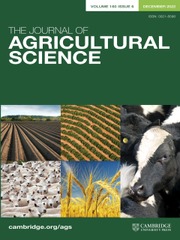Article contents
β-Globulin polymorphism and economic factors in dairy cattle
Published online by Cambridge University Press: 27 March 2009
Extract
1. The serum β-globulin phenotype of 141 bulls located at Cattle Breeding Centres in England and Wales was determined by starch-gel electrophoresis.
2. The distribution of the contemporary comparison values of these bulls with respect to β-globulin type was investigated. The great majority of the bulls were βAA, βAD, or βDD with very few βAE and βDE and no βEE types.
3. The contemporary comparison values for 130 bulls of the three types βAA, βAD and βDD each fell into a normal distribution. The mean and its standard error and the standard deviation of the mean and its standard error were calculated for each of the three curves. The mean contemporary comparison value for the βAA bulls was + 12·2 ± 5·4 gal., for the βAD bulls + 26·8 ± 5·4 gal., and for the βDD bulls + 38·2 ± 5·5 gal. The βAA and βDD means were significantly different (P < 0·01).
4. The pooled contemporary comparison values of the βAA, βAD and βDD bulls did not give a normal distribution curve, neither did the contemporary comparison values for a sample of 1028 bulls quoted by the Milk Marketing Board. However, when the contemporary comparison values of the βAA, βAD and βDD groups were superimposed around the same mean, the ensuing distribution was normal.
5. It is concluded that the β-globulin locus is concerned in the genetic control of milk yield. The estimated mean genetic value of βD over βA is approximately + 50 gal. This is about one-sixth of the total genetic variation in milk yield in the major milk breeds.
6. The distribution of butterfat percentages with respect to β-globulin phenotype in four Ayrshire and one Friesian herds was investigated. No difference between the mean first lactation butterfat percentage of the βAA, βAD, and βDD cows in each herd was found. There was an indication (not significant) that the mean butterfat percentage of the βAE and βDE cows in three of the four Ayrshire herds studied was higher than the mean of the other groups.
Information
- Type
- Research Article
- Information
- Copyright
- Copyright © Cambridge University Press 1960
References
REFERENCES
- 38
- Cited by

